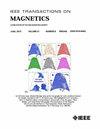基于正弦功率时钟的新型高能效写入电路,适用于 CMOS/MTJ 混合架构
IF 2.1
3区 工程技术
Q3 ENGINEERING, ELECTRICAL & ELECTRONIC
引用次数: 0
摘要
自旋转矩磁性随机存取存储器(STT-MRAM)与 CMOS 兼容,具有密度高、可扩展和不易挥发等特点,为低功耗和高密度存储器提供了一种前景广阔的解决方案。然而,写入位单元所需的较高能量仍然是将其应用于电池驱动智能手持设备的关键挑战。现有的低能耗写入解决方案需要额外的复杂控制逻辑机制,进一步限制了可用面积。在这项研究中,我们提出了一种结合两种技术设计高能效写入电路的解决方案。首先,我们提出了正弦电源时钟机制,以取代传统 CMOS 设计中的直流电源。其次,我们提出了三个基于查找表(LUT)的控制逻辑电路和一个写入电路,以减少面积并进一步降低能耗。实验结果在使用以下位单元配置设计的 $4 \times 4$ STT-MRAM 宏的案例研究实现中得到了验证:i) 一个晶体管和一个磁隧道结 (MTJ)(1T-1MTJ);ii) 四个晶体管和两个 MTJ(4T-2MTJ)。在 250 kHz 至 6.25 MHz 频率范围内进行的布局后仿真显示,与 CMOS 对应电路相比,使用所提出的基于 LUT 的控制逻辑电路和正弦电源的写入驱动器的写入电路平均节能 65.05% 以上。此外,与 CMOS 对应电路相比,使用建议的正弦电源 6T 写入驱动器的写入电路的节能效果提高了 70.60% 以上。我们还验证了节能性能与温度和隧穿磁阻(TMR)比的变化保持相对一致。本文章由计算机程序翻译,如有差异,请以英文原文为准。
A Novel Energy-Efficient Sinusoidal Power Clocking-Based Writing Circuitry for the Hybrid CMOS/MTJ Architecture
Spin transfer torque magnetic random access memory (STT-MRAM) offers a promising solution for low-power and high-density memory due to its compatibility with CMOS, higher density, scalable nature, and non-volatility. However, the higher energy required to write bit cells has remained a key challenge for its adaptation into battery-operated smart handheld devices. The existing low-energy writing solutions require additional complex control logic mechanisms, further constraining the available area. In this research, we propose a solution to design energy-efficient write circuits by incorporating two techniques together. First, we propose the sinusoidal power clocking mechanism replacing the DC power supply in the conventional CMOS design. Second, we propose three lookup table (LUT)-based control logic circuits and one write circuit to reduce the area and further minimize energy dissipation. The experimental results are verified over the case study implementations of
$4 \times 4$
STT-MRAM macro designed using bit cell configurations: i) one transistor and one magnetic tunnel junction (MTJ) (1T-1MTJ) and ii) four transistors and two MTJs (4T-2MTJ). The post-layout simulation for the frequency range from 250 kHz to 6.25 MHz shows that the write circuit, which uses the proposed LUT-based control logic circuits and a write driver with a sinusoidal power supply, achieves more than a 65.05% average energy saving compared to the CMOS counterpart. Furthermore, the write circuit, which uses the proposed 6T write driver with the sinusoidal power supply, shows an improvement in energy saving by more than 70.60% compared to the CMOS counterpart. We also verified that the energy-saving performance remains relatively consistent with the change in temperature and the tunneling magnetoresistance (TMR) ratio.
求助全文
通过发布文献求助,成功后即可免费获取论文全文。
去求助
来源期刊

IEEE Transactions on Magnetics
工程技术-工程:电子与电气
CiteScore
4.00
自引率
14.30%
发文量
565
审稿时长
4.1 months
期刊介绍:
Science and technology related to the basic physics and engineering of magnetism, magnetic materials, applied magnetics, magnetic devices, and magnetic data storage. The IEEE Transactions on Magnetics publishes scholarly articles of archival value as well as tutorial expositions and critical reviews of classical subjects and topics of current interest.
 求助内容:
求助内容: 应助结果提醒方式:
应助结果提醒方式:


